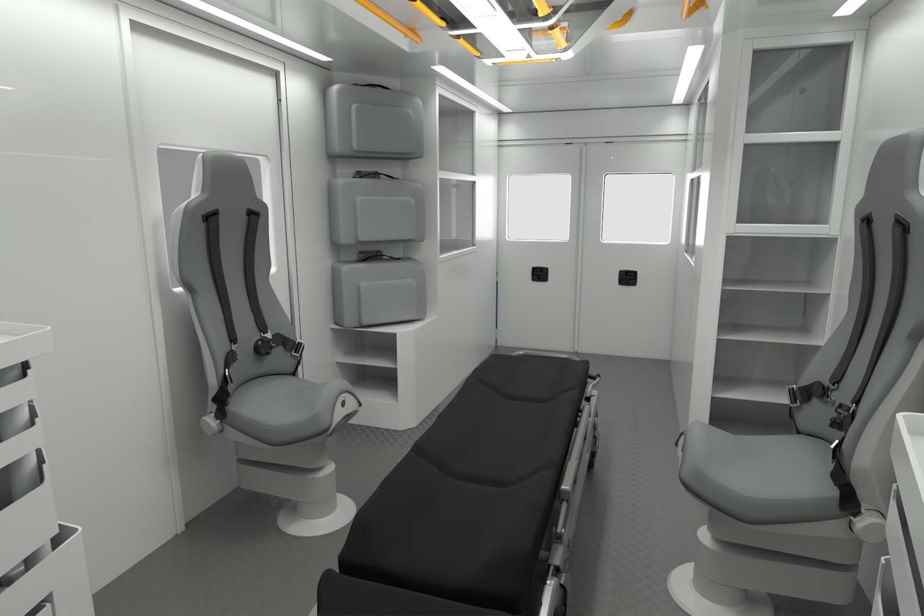With the industrial design firm Brio Innovation, the manufacturer Demers Ambulances has developed a seat that can save lives – including that of the paramedic.
Posted at 11:00 a.m.
innovation
On the road, its ergonomics and the articulated arm of its base allow the paramedic ambulance technician to carry out all the maneuvers surrounding the patient on a stretcher, while remaining restrained by a four-point safety belt.
The context
In traditional North American ambulances, the paramedic sat on a bench seat alongside the stretcher, restrained by a two-point seat belt that he rarely buckled.
In 2012, Demers Ambulances received a call from Calgary, where they had deplored an ambulance accident in which the unrestrained technician had suffered serious injuries.
The Quebec manufacturer then developed a wheelchair system that slid on a rail placed parallel to the stretcher, a device that has become widespread.
But certain peripheral gestures encouraged the paramedic to detach himself on occasion.
The electric ambulance project, launched five years ago in association with Lion Electric, was an opportunity to completely overhaul the interior of the body.
The initial objective was: how to ensure that this time, by rethinking the position of the equipment and the stretcher, we would create a seat where the paramedic could easily move from head to toe and do his job 100% attached. This is when we created our new headquarters.
Alain Brunelle, President of Demers Ambulances
Contrary to the usual procedure, the interior of the passenger compartment was designed before sizing the body.
“We started the work by saying: let’s forget the concept of the chassis, which was a limiting factor for the position of the stretcher and the paramedic, and start from a blank page”, describes Alain Brunelle.
Following interviews, filmed simulations and participation in real interventions with ambulance technicians, Brio’s designers proposed a new layout for the interior space.

IMAGE PROVIDED BY BRIO INNOVATION
“The exercise did not revolve around the head office at all, but the head office quickly became the heart of innovation,” relates Luc Bourgeois, Director, Innovation, at Brio.
Rather than to the left and at the rear of the cabin, the stretcher has been positioned in the middle, with a seat on either side.
Headquarters
Using their long experience in designing seats in public transport, recreational vehicles and aviation, Brio designers have designed an ergonomic seat, whose saddle-shaped configuration allows the technician to push laterally with the legs to move.
Between the thighs, a protuberance forming a stop makes it easier to control movement. “This is what comes to stabilize, which gives the impression that the seat is really glued to the user”, explains Luc Bourgeois.
The lines
The designers opted for simple, segmented and slightly angular lines, which convey the product’s innovation and technology.
They have slimmed down the shapes around the backrest, giving it a finesse that is both aesthetic and functional in this cluttered environment.
The four-point seat belt straps wrap inside the seat through two slots under the headrest.
The joint
For their part, Demers engineers have developed the mechanism of the aluminum base, articulated on three interdependent pivots. The seat can thus move in all directions around its central fixing point.
“There is a lot of engineering in the articulated arm, comments Luc Bourgeois. And that is Demers, in large part. »

IMAGE PROVIDED BY DEMERS AMBULANCES
Demers and Lion’s electric ambulance
Buttons located on the front of the seat and behind the headrest allow the joint to be locked and unlocked, as required.
“Of course it’s a big challenge, to be sure that it’s easy to operate and at the same time safe,” comments Alain Brunelle. If there is an impact on the ambulance, the seat must remain in its place. »
The device is self-locking in the event of an impact. In tests in the United States, it withstood impacts equivalent to almost 23 g.
The future
“It’s a first in the industry,” emphasizes Alain Brunelle. The paramedics who have seen and tried it are all amazed. »
The electric ambulance in which the seat will sit is expected to undergo reliability and certification testing over the summer and fall, likely to go into production in early winter.
The seat will be subcontracted. “The intention is to do that in Quebec. »

